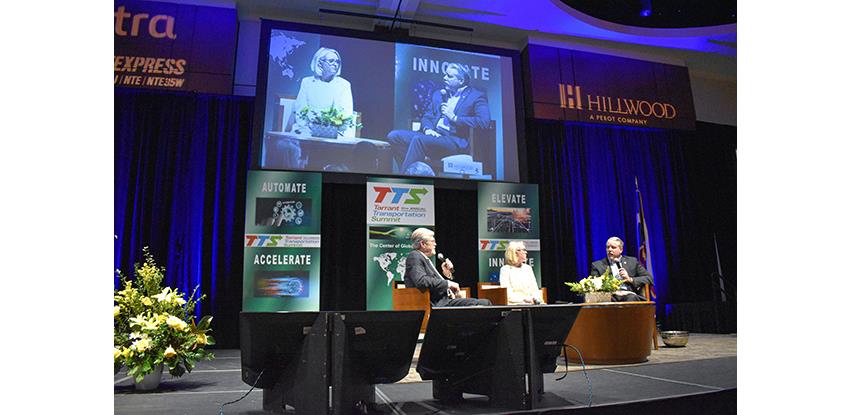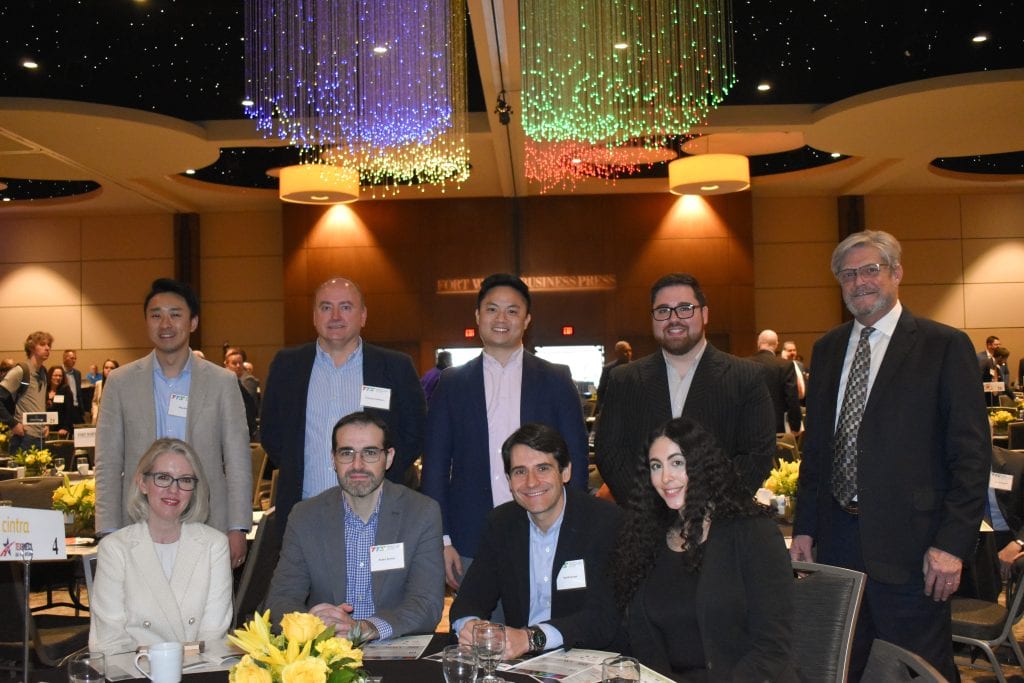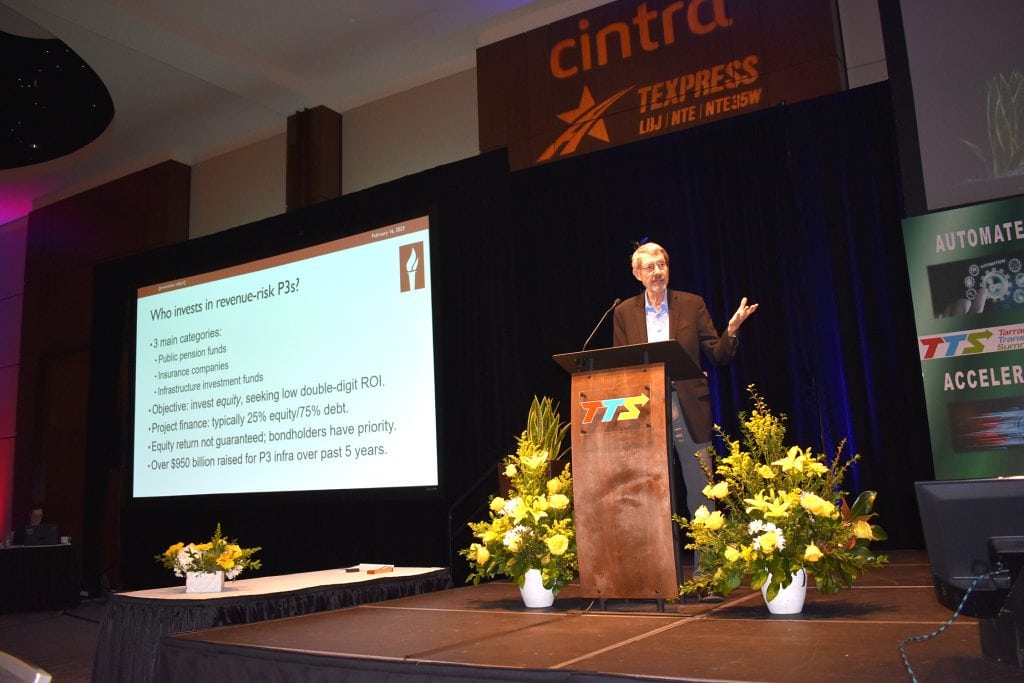
The fact that more than 7 million drivers travel on Cintra-managed corridors in North Texas each year is a testament to the need for and success of our managed lanes and the public-private partnership (P3) model that made it possible.
This success was heralded at the 13th Annual Tarrant Transportation Summit, “Automate, Accelerate, Elevate & Innovate – The Center of Global Mobility,” held Feb. 17 in Hurst, Texas.
Cintra and its TEXpress concessions were the event’s presenting sponsor. Brooke Akins, Cintra’s Global ESG Director, addressed the economic impact of managed lanes on the communities they serve with Craig Hulse, Director of Economic Development for the City of North Richland Hills. Robert Hinkle, Director of Corporate Affairs for our NTE / LBJ / NTE 35W concessions, moderated the panel discussion.
Billed as enhanced mobility in Tarrant County, enhancing economic development in the Dallas-Fort Worth region is what stood out as the main theme.

The P3 Model Solution
Keynote speaker Robert Poole, director of transportation policy at the Reason Foundation and former adviser to four presidential administrations on infrastructure and mobility issues, said Texas has big, unfunded transportation infrastructure needs that a P3 model can successfully fund.
“The advantages of the public-private partnership revenue model really are that it guarantees you to finance these big projects up front, so you get a build when you need it, not 10 or 20 years from now,” Poole said. “Using public-private partnership funds for projects could save TxDOT $6.5 billion near-term to spend elsewhere in the state.”
As an example, Poole pointed to Cintra’s I-66 Outside the Beltway project as a landmark project for others to follow. He said it is only the second P3 project in the U.S. “that is 100 percent revenue financed without any state aide whatsoever,” and then went on to add, “and in addition to paying for all the construction costs, they paid a chunk to support bus transport operations in that corridor.”
When asked about the P3 impact on rural areas, he answered, “The rural areas really should be the biggest promoters because they stand to gain the most from revenue-based financing in the urban areas.” Poole urged Texas leaders to consider wider use of express toll lanes to better manage traffic congestion and even emissions.
Socioeconomic Impact of Managed Lanes
Brooke shared Cintra’s Economic Development and Social Impact Report, which reveals the socioeconomic impacts of Cintra-managed highways — the benefits they generate for society – and how expenditure on these assets generates impacts to employment and gross domestic product (GDP).
“Since their inception through year-end, Cintra highways worldwide contributed a total of $61 billion to the GDP of the countries in which they operate,” Brooke said. “All these impacts will continue to grow over time, and now we can look to optimize and protect those values for our partners, our DOT partners and users of these roadways. We are committed to providing a safer environment for all drivers with a multi-year vision that will adapt and evolve as automated vehicle adoption grows.”
Co-panelist Craig Hulse praised Cintra’s P3 model for making the TEXpress lanes a reality nine months ahead of schedule and creating economic development for the region.
“The public-private partnership structure not only brought the project to life, it solidified its ability to go forward,” Craig said. “This public-private partnership brings forth certainly that people can invest and make decisions versus maybe the funding will come around…, so that’s one real kudo to the public-private partnership structure that you guys are involved in.”
Mobility Challenges in North Texas
The Dallas-Ft. Worth (DFW) metro area currently ranks as the 14th most congested in the United States, despite the DFW metroplex having a 120-mile connected system of TEXpress Lanes serving over one million trips per day across all of our lanes.
With Tarrant County now the fifth-fastest-growing county in the United States with 41 municipalities, according to Tarrant County Administrator G.K. Maenius, the time to relieve congestion and expand capacity and mobility is now.
In Poole’s presentation, “Rethinking Texas Highways,” he argued P3 tolled roadways can solve issues such as congestion, deferred maintenance and a decline in fuel tax revenue, plus the simple fact that this model allows large transportation projects to actually start when needed.

The 2023 Summit
Tarrant County Commissioner Gary Fickes hosted this year’s summit yet again, which drew more than 800 elected officials, business leaders, transportation engineers and members of the public to discuss the present state and future of mobility in Tarrant County.
Other panels explored automation within the U.S. supply chain, driving Texas’ economic development through multimodal transportation planning, accelerating mobility projects throughout North Texas and airport expansion and the future of flight where planes share airspace with delivery drones and air taxis.
Summit speakers included Tarrant County Administrator G.K. Maenius, Fort Worth Interim Director of Transportation & Public Works Lauren Prieur, Tarrant Regional Transportation Coalition Executive Director Victor Vandergriff, Alliance Aviation President Christian Childs, DFW International Airport EVP of Global Strategy and Development John Ackerman, and Caroline Mays, Director of Planning and Modal Programs at the Texas Department of Transportation.
